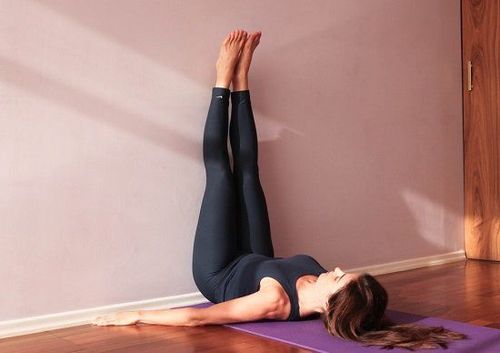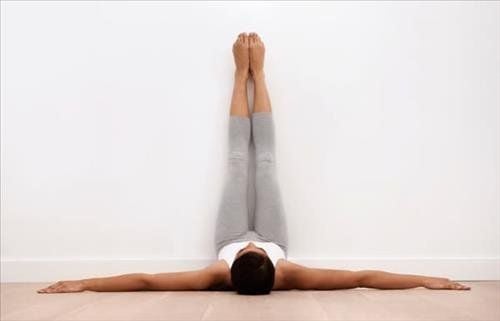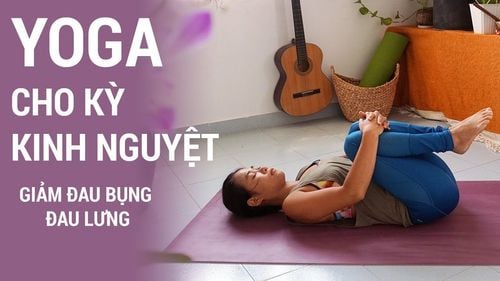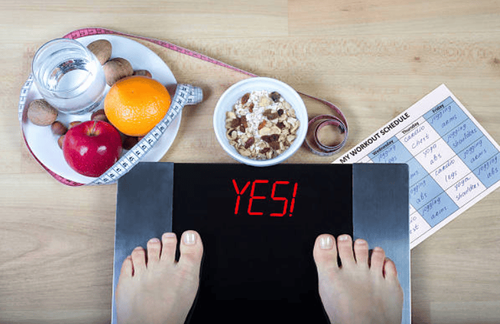This is an automatically translated article.
The footrest on the wall pose in yoga exercises, if done correctly and regularly, will bring many health benefits, including increasing blood circulation, limiting stress and improving sleep. However, putting your feet up against the wall often leads to numbness or pain in your feet. So, is it okay to put your feet on the wall and have numbness in your feet?
1. What is the effect of putting your feet on the wall?
Legs on the wall (also known as Viparita Karani) is a pose in restorative yoga exercises. This easy-to-follow pose brings a lot of health benefits that the practitioner does not need to warm up or prepare anything before.
To perform the leg up on the wall pose, the practitioner does not need the help of any equipment, instead just lie on his back, then bring his buttocks close to the wall and straighten his legs. If you feel uncomfortable, the practitioner can use an extra soft pad under the buttocks, a blanket under the head and a strap around the thighs.
The posture of putting your feet up on the wall brings a number of health benefits as follows:
Enhance detoxification: The movement of raising your legs will stimulate metabolism, increase blood circulation to organs (such as the liver and liver). , kidney) and produces a very strong toxin elimination response; Improve skin: When you put your feet up on the wall, blood circulation will take place faster, at the same time, body temperature will increase, stimulate sweat secretion, thereby expanding the pores and enhancing the elimination of toxins. toxic substances out. Therefore, the skin gradually changes in a positive direction, becoming younger after each exercise; Preventing constipation, stimulating digestion: When the legs are raised, the body has many positive changes, increasing gastrointestinal motility, thereby helping to prevent constipation, improve digestive function and limit the risk of constipation. risk of liver and intestinal diseases; Improve mood, lower blood sugar: According to Oriental medicine, the spleen is the organ that has a direct relationship with the limbs. Therefore, when you put your feet up high, it will stimulate the spleen to work harder, thereby helping to stabilize blood sugar and improve the function of the spleen and stomach. The patient's mood is somewhat stable, balanced and calmer; Reduce stress, improve sleep: According to Oriental medicine, the movement of resting your feet on the wall before sleeping helps practitioners have a quality sleep. Right from the moment the leg is raised, the pressure in the brain has decreased rapidly, thereby eliminating stress, anxiety and improving sleep quality quickly; Reducing the burden on the lungs: When performing this yoga movement, the dantian area will also be exercised and increase oxygen supply to the lungs, thereby helping to reduce the burden and enhance the function of the lungs; Protecting the spine, preventing osteoarthritis: When you put your legs straight on the wall, the lumbar spine area will be kept in a flat and stable state, and the muscles of the whole body have flexible elasticity and gas. Convenient blood circulation, maintenance of joint function. As a result, restore nerve function in the spine and pelvis, protect the spine and prevent degeneration; In addition, some other benefits of the foot-on-the-wall pose, such as helping to improve headaches, migraines, nausea, varicose veins; Give your feet time to rest after being physically active throughout the day; Hormonal balance;

Gác chân lên tường mang lại rất nhiều tác dụng có lợi cho sức khỏe người tập
2. Is it okay to put your feet on the wall and get numb?
This yoga move can be simple, easy to do and brings many health benefits, but some people have foot on the wall condition, leg numbness, pain or discomfort. According to experts, having numbness in the legs when resting the feet on the wall is a sign that the body's injuries are in the process of recovery, so it is usually not serious and does not require any treatment.
However, putting your feet up against the wall and numbness in your legs can be the result of poor posture or wrong method. Therefore, an important requirement is that the practitioner must ensure that the correct posture is performed according to yoga standards. If you have any questions or concerns about putting your feet up on the wall and having numbness in your feet, it's best to talk to your trainer or instructor directly.
3. What to do if you put your feet on the wall and have numbness in your feet?
The movement of resting your feet on the wall can stretch the muscles of your legs, but it rarely causes pain or numbness. If you experience numbness in your legs when resting your feet on the wall or experience other discomfort, just gently change the position of your butt away from the wall until it is most comfortable.
Beginner stage, the practitioner should only maintain this posture for about 3-5 minutes and when adapted, increase the practice time to 10-15 minutes. However, if leg rest against the wall is causing leg numbness (including feet or calves) to the point of being unbearable, feel free to lower your legs to the wall, temporarily rest, and exit the pose.
If the condition of the leg numbness when pressing the foot on the wall is still not improved, the practitioner needs to talk to the doctor for specific instructions on how to overcome it.
4. How to do the right footrest on the wall
Legs up the wall pose can be done relatively simply and sometimes without the guidance of a yoga instructor. However, if exercising in the wrong method sometimes causes many unpleasant signs such as pain or numbness. Therefore, the best way is still to go to professional yoga classes to exchange and receive guidance from a trainer. In addition, practitioners can learn how to do this beneficial pose through tutorials on the internet.
The following are the steps to perform the footrest on the wall:
Put a soft blanket or yoga mat on the floor, next to the wall and can use a small pillow to prop your head when needed; The practitioner lies on his back with his buttocks close to the wall. Ideally, the tailbone should remain on the floor and the buttocks as close to the wall as possible. Keep your back and head in line and perpendicular to the wall; Raise your legs and lean against the wall, relax your knees, and feet are parallel to the floor. At this time, the practitioner will feel the legs stretch, but often create a feeling of pain; Slowly take a deep breath and relax for 2-3 minutes or maintain this movement longer if you have adapted; Once the goal has been achieved, the practitioner should slowly come out of the standing position on the wall. Then carefully, gently switch to a sitting position, holding for at least 30 seconds. Some notes when performing the footrest movement on the wall:
Practitioners should choose comfortable clothes to relax the body completely, limiting the obstruction of blood circulation; This move is not suitable for people with recent or chronic leg or spine injuries; Some common mistakes people make, such as lying too far or too close to the wall, placing pillows or blankets that are too soft under their backs... can lead to muscle tension and interfere with spine balance; This movement can be done at any time except for the period of 30 minutes after eating; It should be done twice a day in the morning and in the evening before going to bed.

Đông tác gác chân lên tường cần được thực hiện chính xác
5. Who shouldn't do the leg up the wall?
Besides leg numbness on the wall, this move, like other yoga exercises, can bring some risks and contraindications. Therefore, the following situations should be avoided:
5.1. Glaucoma. Therefore, this yoga movement is considered unsafe for glaucoma patients. Experts say that although pressure in the eye can return to normal when the patient returns to a sitting position, glaucoma cases are best avoided in the foot-up position.
5.2. Conditions that cause swelling, fluid retention Patients with certain medical conditions that can cause excessive fluid accumulation (or edema) should avoid wall-stands. Patients should not perform this position on their own or if so, it is necessary to have the guidance and supervision of medical staff, because when done, it will cause a large amount of fluid to return to the circulatory system and overload the body. heart. Some diseases that cause fluid retention include:
Congestive heart failure; CKD; Liver failure or cirrhosis. 5.3. Uncontrolled blood pressure Patients with high blood pressure that have not or cannot be controlled should avoid putting their feet up against the wall, as this can increase blood pressure even more. However, when the blood pressure index has been stabilized, the patient can completely perform this yoga pose to improve many other health problems.
Hope the information in the above article has helped you answer the question "Is it okay to put your feet on the wall and get numb?". If you have any questions or concerns, you should speak to your coach or instructor directly.
Follow Vinmec International General Hospital website to get more health, nutrition and beauty information to protect the health of yourself and your loved ones in your family.
Please dial HOTLINE for more information or register for an appointment HERE. Download MyVinmec app to make appointments faster and to manage your bookings easily.













